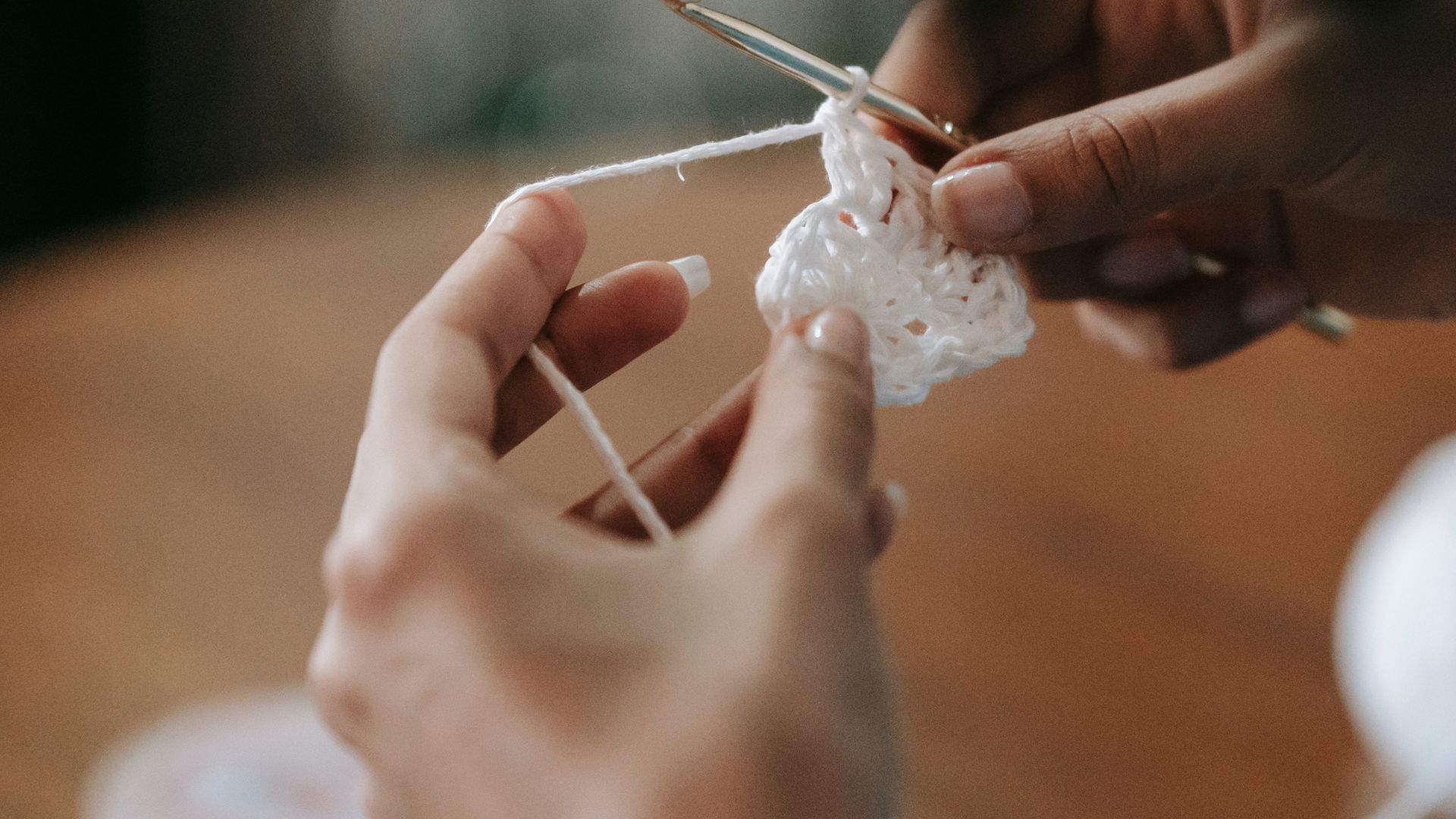Crocheting is a delightful and creative craft that allows you to produce beautiful pieces of fabric using just a hook and some yarn. If you’re new to crocheting, one of the fundamental skills to master is how to hold a crochet hook correctly. The right grip can significantly impact your comfort and efficiency while crocheting. Let’s delve into the steps on how to hold a crochet hook properly:
Why Holding Your Crochet Hook Matters
Before diving into the specific techniques, it’s essential to understand why the way you hold your crochet hook is important. A comfortable and efficient grip can:
- Enhance Control: Proper grip improves your control over the hook, enabling smoother and more accurate stitches.
- Reduce Strain: Holding the hook correctly reduces strain on your hands and wrists, allowing for longer, more enjoyable crocheting sessions.
- Improve Speed: A good grip can enhance your crocheting speed, making the process more efficient.
Steps to Hold a Crochet Hook
- Choose the Right Hook: Select a crochet hook that feels comfortable in your hand. Hooks come in various materials and sizes, so try a few to find what suits you best.
- Hold Like a Pencil or Knife:
- Pencil Grip: Hold the hook between your thumb and index finger, similar to how you hold a pencil. This grip allows for more control.
- Knife Grip: Hold the hook handle between your thumb and middle finger, with the thumb resting on the flat part of the handle and the index finger on top. This grip offers stability and works well for larger hooks.
- Relax Your Grip: Avoid gripping the hook too tightly; a relaxed grip helps prevent hand fatigue and allows for smoother movements.
- Find Your Comfort Zone: Experiment with both grips to see which one feels more natural and comfortable for you. Everyone’s hands are different, so there’s no one-size-fits-all approach.
- Practice Consistently: Like any skill, holding a crochet hook proficiently comes with practice. Don’t be discouraged if it feels awkward initially – with time, it’ll become second nature.

Close-up of Woman Crocheting
Additional Tips for Comfortable Crocheting
- Posture Matters: Sit in a comfortable, well-supported position with good lighting to avoid straining your neck and back.
- Take Breaks: To prevent hand fatigue and strain, take regular breaks during extended crocheting sessions.
- Stay Relaxed: Keep your hands and wrists relaxed while crocheting to avoid tension and potential discomfort.
By mastering the art of holding your crochet hook comfortably, you’re setting yourself up for an enjoyable crocheting experience. Experiment with different grips, find what works best for you, and remember to practice regularly to refine your technique.
For further guidance on crochet techniques and patterns, check out these helpful resources:
- Crochet Guild of America – Offers a wealth of information for beginners and experienced crocheters alike.
- Ravelry – A community-driven platform with patterns, forums, and resources for crochet enthusiasts.
- Craft Yarn Council – Provides guides, tips, and standards for yarn crafting.
Moving forward
Diving deeper into the art of crocheting involves not just holding the hook but understanding the various techniques and stitches that make up this beautiful craft. Let’s explore some commonly asked questions and delve into more aspects of crocheting:
Exploring Crochet Techniques and Stitches
1. Basic Crochet Stitches
Crocheting comprises fundamental stitches that form the foundation of any project. Here are a few essential ones:
- Chain Stitch (Ch): The starting point for almost all crochet projects, creating a foundation row.
- Single Crochet (SC): A basic stitch used for tight and dense fabric.
- Double Crochet (DC): Taller than single crochet, creating a more open and airy fabric.
- Half-Double Crochet (HDC): Offers a balance between height and density.
2. Reading Crochet Patterns
Understanding crochet patterns is crucial for following instructions accurately. They typically include:
- Abbreviations: Familiarize yourself with common abbreviations used in patterns, such as SC for single crochet and DC for double crochet.
- Symbols: Some patterns use symbols to represent stitches, making it essential to grasp these symbols’ meanings.
3. Tension and Gauge
- Tension: Refers to how tightly or loosely you crochet. Consistent tension ensures uniformity in your stitches.
- Gauge: Determining the number of stitches and rows per inch. It’s crucial when following a pattern to achieve the intended size.
4. Joining Yarn and Changing Colors
- Joining Yarn: To start a new yarn ball, simply loop it through your stitch and continue crocheting.
- Changing Colors: Introduce a new color by completing the last stitch of the old color with the new one.
5. Advanced Techniques
Once comfortable with the basics, explore advanced techniques like:
- Crocheting in the Round: Creating circular patterns for items like hats, coasters, or amigurumi.
- Post Stitches: Front and back post stitches add texture and depth to your work.
- Lace Crochet: Intricate patterns using chains and double crochets to create lace-like designs.
Tips for Crocheting Success
- Patience and Practice: Don’t rush the learning process. Practice regularly and be patient with yourself as you improve.
- Experiment and Explore: Don’t be afraid to try new patterns or techniques. It’s through experimentation that you grow as a crocheter.
- Join Communities: Online or local crochet groups offer support, inspiration, and a platform to share your creations.
Wrapping Up
Mastering the art of crocheting involves dedication, practice, and a willingness to learn. As you progress, remember that mistakes are part of the learning process, and each project is an opportunity to improve.
Keep honing your skills, exploring new patterns, and enjoying the therapeutic and creative journey that crocheting offers.
If you want to explore more patterns or techniques:
- AllFreeCrochet – Offers a vast collection of free crochet patterns for all skill levels.
- The Spruce Crafts – Provides tutorials, patterns, and tips for crochet enthusiasts.
- LoveCrafts – A platform with patterns, yarn, and tools for various crafts, including crochet.
Comparison tabular
Crochet Hook Grips Comparison Table
| Grip Style | Description | Advantages | Disadvantages |
|---|---|---|---|
| Pencil Grip | Hold the hook like a pencil between thumb and index finger | – Offers precise control over stitches | – May cause hand fatigue with prolonged use |
| Knife Grip | Hold the hook handle between thumb and middle finger | – Provides stability and support | – Might be challenging for those with smaller hands |
| Ergonomic Grips | Hooks with specially designed handles for comfortable hold | – Reduces hand strain and fatigue | – Personal preference may vary for ergonomic designs |
| Tunisian Crochet Hook | Longer hook used for Tunisian or Afghan crochet | – Allows for working on multiple stitches at once | – Requires learning a specific technique |
Crochet Stitches Comparison Table
| Stitch Type | Description | Best Use | Characteristics |
|---|---|---|---|
| Single Crochet (SC) | Short and dense stitch, ideal for tight fabric | Amigurumi, washcloths | Offers less stretch, compact fabric |
| Double Crochet (DC) | Taller stitch, creates an open and airy fabric | Blankets, scarves, shawls | Works up quickly, great for larger projects |
| Half-Double Crochet | Sits between SC and DC in height, offering a balance of density and height | Hats, dishcloths, bags | Provides more coverage than SC, less height than DC |
| Slip Stitch | Shortest stitch used for joining, creating a nearly invisible seam | Joining rounds, finishing edges | Gives a tight, subtle seam |
Crochet Techniques Comparison Table
| Technique | Description | Best Use | Key Features |
|---|---|---|---|
| Crocheting in the Round | Working in a continuous spiral or joined rounds to create circular patterns | Hats, amigurumi, coasters | Requires stitch marker for tracking rounds, seamless finish |
| Post Stitches | Stitches worked around the post of previous stitches, creating texture | Ribbing, cables, raised patterns | Front and back post stitches add depth and dimension |
| Changing Colors | Introducing new colors into the project by switching yarns | Colorwork, stripes, patterns | Techniques like color pooling and tapestry crochet possible |
Tables like these can be handy references for crocheters, offering a quick comparison of various grips, stitches, or techniques. Experimenting with different styles and techniques can enhance your crochet skills and expand your repertoire of projects.
Wrapping up
As you journey into the world of crochet, remember that the beauty of this craft lies not just in the finished creations but also in the joy of the process itself. Embrace the learning curve, cherish each stitch, and allow yourself the freedom to explore and create.
Whether you prefer the pencil grip for its precision or the stability of the knife grip, whether you’re diving into intricate lace patterns or creating cozy blankets with simple stitches, your unique style and creativity are what make your crocheting endeavors special.
Keep your hooks busy, your yarn colorful, and your heart open to the endless possibilities that crocheting brings. With every project, you’re weaving more than just yarn – you’re weaving memories, joy, and a piece of yourself into every stitch.
May your hooks glide smoothly, your stitches be even, and your crocheting journey be filled with inspiration and fulfillment. Happy crocheting!

For over a decade, I’ve been Mike, an artist, crafter, and designer deeply immersed in the Croc world. I thrive on crafting unique, size-inclusive patterns, fostering creativity, and sharing them on ktforum.com. My designs aim to ignite your creative spark and delight you, ensuring clarity and ease of use through rigorous testing. Join me in expressing your creative flair and showcasing your craft with joy.
Related Posts
- Exploring the World of Crochet Hooks: A Comprehensive Guide
Crochet, a craft as old as time, involves creating beautiful fabric using yarn and a…
- Using Different Hook Sizes in Crochet Projects: A Complete Guide
Crocheting offers a delightful avenue for creativity, and the choice of hook size can significantly…
- Mastering Color Changes in Crochet: A Comprehensive Guide
Crochet is an incredible craft that allows you to create beautiful, intricate designs using yarn…
- Basic Crochet Stitches: A Guide for Beginners
Crocheting opens up a world of creativity and craftsmanship, allowing you to create beautiful pieces…

